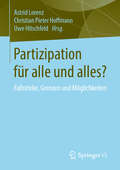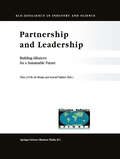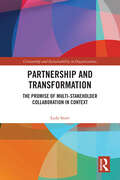- Table View
- List View
Partizipation — Demokratisierung — Mitbestimmung: Problemstellung und Literatur in Politik, Wirtschaft, Bildung und Wissenschaft. — Eine Einführung (Studienbücher zur Sozialwissenschaft #19)
by Wolfgang Tönnesmann Volker SommerProblemstand und Literatur in Politik, Wirtschaft, Bildung und Wissenschaft. Eine Einführung. Mit Beiträgen von Ulrich von Alemann, Michael J. Buse, Peter v. Ehrhardt, Wilfried Nelles, Paul G. Schmitz, Michael Schmunk, Rainer Siegelkow, Henning von Vieregge, Bernhard Wanders.
Partizipation durch Werkstatträte (Beiträge zur Teilhabeforschung)
by Viviane SchachlerIn diesem Open-Access-Buch liefert Viviane Schachler die erste umfassende Bestandsaufnahme dazu, wie die Mitwirkung und Mitbestimmung in Werkstätten für behinderte Menschen (WfbM) jenseits der rechtlichen Vorgaben tatsächlich ausfällt. Werkstatträte sind die gewählte Interessenvertretung von rund 300.000 Menschen mit Behinderungen in WfbM, wozu seit 2001 die Werkstätten-Mitwirkungsverordnung besteht. Mit einer Mixed-Methods-Studie kann – u. a. in Form von Indizes, Zusammenhangs- und Regressionsanalysen – nachgezeichnet werden, wie aktiv, autonom und durchsetzungsstark die Gremien arbeiten. Damit gelingt es, das Postulat der Partizipation von Menschen mit Behinderungen mit einer konkreten Beteiligungsform näher auszuführen und diese empirisch fundiert in den fachlichen Diskurs der Teilhabeforschung einzuordnen.
Partizipation für alle und alles?: Fallstricke, Grenzen und Möglichkeiten
by Astrid Lorenz Christian Pieter Hoffmann Uwe HitschfeldBasierend auf einer Darstellung herausfordernder Projekte, diskutiert der Band Grenzen der politischen Partizipation in Deutschland und identifiziert Erfolgsfaktoren. Zunächst rücken ausgewählte Projekte in das Blickfeld, bei denen Bemühungen um mehr Partizipation nicht immer zum gewünschten Ergebnis führten. Grenzen der Beteiligung im politischen System der Bundesrepublik Deutschland werden systematisch analysiert. Vor diesem Hintergrund arbeiten mehrere Beiträge schließlich Erfolgsfaktoren für Partizipation heraus. So entsteht ein fundiertes Bild von Beteiligung als kommunikatives Verfahren der Integration und kollektiven Entscheidungsfindung aus Sicht von Wissenschaft und Praxis.
Partizipation in der Einwanderungsgesellschaft (Interkulturelle Studien)
by Wolf-Dietrich Bukow Markus Ottersbach Sonja Preissing Bettina LöschAnfang des Jahres 2008 demonstrierten vor allem junge Kalkerinnen und Kalker mit Migrationshintergrund über mehrere Tage gegen ihre Benachteiligung in der Einwanderungsgesellschaft. Dazu fanden Demonstrationen, spontane Treffen, Sitzblockaden, Mahnwachen, Diskussionsrunden und weitere Aktionen statt. Die Ereignisse wurden in den Medien auf städtischer, regionaler und nationaler Ebene diskutiert. In dem Forschungsprojekt ging es unter anderem darum, die Perspektiven und Reaktionen der Beteiligten der Demonstrationen und der verschiedenen Akteurinnen und Akteuren im Stadtteil zu untersuchen. Ziel des Projektes war, an dem konkreten Beispiel der Kalker Ereignisse das Potenzial zivilgesellschaftlicher Aktionen von Menschen mit Migrationshintergrund aufzuzeigen.
Partizipation trifft Repräsentation: Die Wirkungen konsultativer Bürgerbeteiligung auf politische Entscheidungen
by Martina NeuneckerMartina Neunecker betrachtet in Ihrer Studie die Rolle konsultativer Verfahren der Bürgerbeteiligung. Den vielfältigen Ursachen dafür, warum diese nur in einzelnen Fällen substanziell die Entscheidungen kommunaler Parlamente beeinflussen, geht sie erstmals anhand eines vergleichenden, systematischen und theoretisch fundierten Ansatzes nach. Am Beispiel des Verfahrens „Bürgerhaushalt“ in 13 deutschen Kommunen untersucht die Autorin, inwiefern etwa die Entscheidungsmotive der gewählten Repräsentanten oder der Kontext des Verfahrens dazu führen, dass Instrumente repräsentativer und partizipativer Demokratie häufig unvereinbar erscheinen.
Partizipation von Frauen am Islamismus: Ziele, Motive, Aktivitäten und Konflikte
by Hoda SalahHoda Salah untersucht die Beweggründe von Frauen der Muslimbruderschaft, des Salafismus und des Liberalislam, am Islamismus teilzunehmen sowie deren Ziele. Am Beispiel des semisäkularen Ägypten wird gezeigt, dass Themen wie politische Teilhabe, Einflussnahme, Parlamentskandidaturen und Führungspositionen im Staat und der Gesellschaft besondere Anliegen von Muslimschwestern, Salafistinnen und Wasataktivistinnen sind. Aktivistinnen kreieren neue Themen wie islamischen Feminismus und islamische Sexualität und verwenden diese gezielt als Mobilisierungspotenzial. Ihre Konflikte mit säkularen Aktivistinnen um Universalismus oder Partikularismus der Menschen- und Frauenrechte werden erklärt. Die Ergebnisse lassen sich teilweise generalisieren und werfen Fragen für den deutschen Diskurs zum Islamismus auf.
Partizipation von Kindern und Jugendlichen: Formen, Bedingungen sowie Möglichkeiten der Mitwirkung und Mitbestimmung in der Schweiz (Kinder, Kindheiten und Kindheitsforschung)
by Peter Rieker Rebecca Mörgen Anna Schnitzer Holger StroezelIm Zentrum dieser Studie stehen Partizipationsmöglichkeiten, die Kindern und Jugendlichen in Familie, Schule und Gemeinde zur Verfügung stehen. In den verschiedenen Bereichen sind die Umsetzungen von Mitwirkung und Mitbestimmung durch unterschiedliche Spannungsverhältnisse gekennzeichnet und werden von den beteiligten Akteuren unterschiedlich bewertet. Die multimethodisch und multiperspektivisch angelegte Studie geht auf die Bedingungen und die Dynamiken von Partizipation von Kindern und Jugendlichen ein und identifiziert Herausforderungen, die sich in den verschiedenen Kontexten des Aufwachsens in Hinblick auf Beteiligung zeigen.
Partizipative Governance: Beteiligungsformen und Beteiligungsrechte im Mehrebenensystem der Klimapolitik
by Heike WalkHeike Walk greift drei aktuelle Themen der politikwissenschaftlichen Forschung auf: die Partizipations- und Governancedebatte sowie die Klimapolitik. Die Autorin setzt sich mit der demokratietheoretischen Relevanz von Governanceprozessen auseinander und legt die vielfältigen Beteiligungsformen nichtstaatlicher Akteure auf den verschiedenen Ebenen der Klimapolitik dar. Dabei steht die These im Vordergrund, dass sich ein wirksamer Klimaschutz nicht allein durch eine breite Öffentlichkeits- und Informationspolitik durchsetzen lässt, sondern auch der breiten Einbeziehung und des Mitmachens weiter Teile der Bevölkerung bedarf.
Partizipative und deliberative Demokratie auf lokaler Ebene: Eine Vermessung der Beteiligungslandschaft Baden-Württembergs (Politik gestalten - Kommunikation, Deliberation und Partizipation bei politisch relevanten Projekten)
by Uwe RemerDialogorientierte Beteiligungsverfahren finden in vielfältigen Formaten zu einer Vielzahl von Themen statt. Die vorliegende Studie von Uwe Remer liefert erstmals belastbare Zahlen zu Umfang und Ausmaß dialogorientierter Beteiligung auf der lokalen politischen Ebene und prüft, welche strukturellen Faktoren die Intensität der Beteiligungspraxis beeinflussen. Der Autor entwickelt ein neues Erhebungsverfahren, welches mittels teilautomatisierten Webscrapings das Auftreten von Beteiligungsereignissen erfasst. Es zeigt, dass dialogorientierte Bürgerbeteiligung eine große Verbreitung hat.
Partnering with Extremists: Coalitions between Mainstream and Far-Right Parties in Western Europe
by Kimberly A TwistAs long as far-right parties—known chiefly for their vehement opposition to immigration—have competed in contemporary Western Europe, many have worried about these parties’ acceptability to democratic voters and mainstream parties. Yet, rather than treating the far right as pariahs, major mainstream-right parties have included the far right in 15 governing coalitions from 1994 to 2017. Parties do not care equally about all issues at any given time, and Kimberly Twist demonstrates that far-right parties will agree to support the mainstream right’s goals more readily than many other parties, making them appealing partners. Partnering with Extremists builds on existing work on coalition formation and party goals to propose a theory of coalition formation that works across countries and over time. The evidence comes from 19 case studies of coalition formation in Austria and the Netherlands, countries where far-right parties have been excluded when they could have been included and included when the mainstream right had other options. The argument is then extended to countries where coalitions are less common, France and the United Kingdom, and to cases of mainstream-right adoption of far-right themes. Twist incorporates both office and policy considerations in her argument and reimagines “policy” to be a two-dimensional factor; it matters not just where parties are located on an issue but how firmly they hold those positions.
Partners and Rivals: Representation in U.S. Senate Delegations
by Wendy J. SchillerCongressional scholars have vastly underappreciated how representation in the U. S. Senate differs from the House of Representatives. In this provocative new study, Wendy J. Schiller develops a theory of dual representation--where two legislators share the same geographical constituency--to explain Senators' behavior. Noting that Senators from the same state join different committees, focus on different policy areas, and address different economic interests through bill and amendment sponsorship, the author examines the electoral and institutional forces that elicit this competitive behavior. In developing her theory, Schiller relies on a wide variety of methodologies, from statistical analysis to case studies, and makes telling comparisons with similar situations in Latin America and Asia. Partners and Rivals argues against the commonly held view that individual Senators do an inadequate job in representing their states. Instead, this book demonstrates how the competitive structure of Senate delegations creates the potential for broad and responsive representation in the Senate. When two senators from the same state are viewed as a pair, it becomes clear that their combined representational agendas include a wide range of the interests and opinions that exist among constituents in their state. This holds true whether the Senators are from the same party or not. Rich in details, Partners and Rivals is the most thorough and rigorous explanation of Senators' behavior available.
Partners and Rivals: Representation in U.S. Senate Delegations
by Wendy J. SchillerCongressional scholars have vastly underappreciated how representation in the U. S. Senate differs from the House of Representatives. In this provocative new study, Wendy J. Schiller develops a theory of dual representation--where two legislators share the same geographical constituency--to explain Senators' behavior. Noting that Senators from the same state join different committees, focus on different policy areas, and address different economic interests through bill and amendment sponsorship, the author examines the electoral and institutional forces that elicit this competitive behavior. In developing her theory, Schiller relies on a wide variety of methodologies, from statistical analysis to case studies, and makes telling comparisons with similar situations in Latin America and Asia. Partners and Rivals argues against the commonly held view that individual Senators do an inadequate job in representing their states. Instead, this book demonstrates how the competitive structure of Senate delegations creates the potential for broad and responsive representation in the Senate. When two senators from the same state are viewed as a pair, it becomes clear that their combined representational agendas include a wide range of the interests and opinions that exist among constituents in their state. This holds true whether the Senators are from the same party or not. Rich in details, Partners and Rivals is the most thorough and rigorous explanation of Senators' behavior available.
Partners and Rivals: Representation in U.S. Senate Delegations
by Wendy J. SchillerCongressional scholars have vastly underappreciated how representation in the U. S. Senate differs from the House of Representatives. In this provocative new study, Wendy J. Schiller develops a theory of dual representation--where two legislators share the same geographical constituency--to explain Senators' behavior. Noting that Senators from the same state join different committees, focus on different policy areas, and address different economic interests through bill and amendment sponsorship, the author examines the electoral and institutional forces that elicit this competitive behavior. In developing her theory, Schiller relies on a wide variety of methodologies, from statistical analysis to case studies, and makes telling comparisons with similar situations in Latin America and Asia. Partners and Rivals argues against the commonly held view that individual Senators do an inadequate job in representing their states. Instead, this book demonstrates how the competitive structure of Senate delegations creates the potential for broad and responsive representation in the Senate. When two senators from the same state are viewed as a pair, it becomes clear that their combined representational agendas include a wide range of the interests and opinions that exist among constituents in their state. This holds true whether the Senators are from the same party or not. Rich in details, Partners and Rivals is the most thorough and rigorous explanation of Senators' behavior available.
Partners in deterrence: US nuclear weapons and alliances in Europe and Asia
by Stephan Frühling Andrew O'NeilFrom the dawn of the atomic age to today, nuclear weapons have been central to the internal dynamics of US alliances in Europe and Asia. But nuclear weapons cooperation in US alliances has varied significantly between allies and over time. Partners in deterrence explores the history of America’s nuclear posture worldwide, delving into alliance structures and interaction during and since the end of the Cold War to uncover the underlying dynamics of nuclear weapons cooperation between the US and its allies. Combining in-depth empirical analysis with an accessible theoretical lens, the book reveals that US allies have wielded significant influence in shaping nuclear weapons cooperation with the US in ways that reflect their own, often idiosyncratic, objectives. Alliances are ecosystems of exchange rather than mere tools of external balancing, Frühling and O’Neil argue, and institutional perspectives can offer an unprecedented insight into how structured cooperation can promote policy convergence.
Partners in East-West Economic Relations: The Determinants of Choice
by Zbigniew M. Fallenbuchl Carl H. McMillanPartners in East-West Economic Relations: The Determinants of Choice covers the proceedings of an international conference of the same name held at Montebello, Quebec on April 26-29, 1978. This conference brings together various professionals to address contemporary international economic relations issues. One of the three major issues tackled in this compilation is the reintegration of the economics of the Soviet Union and Eastern Europe into the international division of labor. This compendium also studies the determinants of the choice of partners in East-West relations at the national and subnational levels. The last major topic concerned in this selection is the similarities and differences between partnerships in the East-West and North-South contexts. This compendium will be of interest to those interested in economics and related disciplines.
Partners in Life and Work: Finding Success Through a Partner Business
by Elma Levy Dov LevyProviding candid advice on the ups and downs of entrepreneurship, this book interweaves the world of tech start-ups, the American immigrant experience, and the realities of running a business with your life partner. Across four decades as entrepreneurs, Elma and Dov Levy faced economic recessions, government shutdowns, work-life balance issues, leadership conflicts, and the emotions of letting go of their company Dovel Technologies – a technology consulting firm that they grew from a space in their attic to a multimillion-dollar operation with major government contracts. In this conversational and practical book they share insights on: How next-generation entrepreneurs can develop business relationships and networking skills, and maintain a high level of risk tolerance and manage risks strategically, including how and when to scale the business. How to stay true to guiding principles as co-owner spouses or woman-owned business entrepreneurs. What trends and opportunities to watch out for in a post-COVID-19 world. Aspiring entrepreneurs, growth-focused founders, family business owners, and government and technology professionals will especially value the Levys’ business and personal success stories, with guidance on how to manage a marriage and business simultaneously, creating boundaries with a home office, and showing mutual respect in the boardroom.
Partners in Life and Work: Finding Success Through a Partner Business
by Elma Levy Dov LevyProviding candid advice on the ups and downs of entrepreneurship, this book interweaves the world of tech start-ups, the American immigrant experience, and the realities of running a business with your life partner. Across four decades as entrepreneurs, Elma and Dov Levy faced economic recessions, government shutdowns, work-life balance issues, leadership conflicts, and the emotions of letting go of their company Dovel Technologies – a technology consulting firm that they grew from a space in their attic to a multimillion-dollar operation with major government contracts. In this conversational and practical book they share insights on: How next-generation entrepreneurs can develop business relationships and networking skills, and maintain a high level of risk tolerance and manage risks strategically, including how and when to scale the business. How to stay true to guiding principles as co-owner spouses or woman-owned business entrepreneurs. What trends and opportunities to watch out for in a post-COVID-19 world. Aspiring entrepreneurs, growth-focused founders, family business owners, and government and technology professionals will especially value the Levys’ business and personal success stories, with guidance on how to manage a marriage and business simultaneously, creating boundaries with a home office, and showing mutual respect in the boardroom.
Partners in Peace: Why Europe and Taiwan Matter to Each Other (Taiwan and World Affairs)
by Zsuzsa Anna FerenczyThis book addresses the following fundamental questions: With the EU seeing Taiwan as a partner on its own merit (rather than exclusively through the China factor lens), how can the two sides consolidate this new normal, what next? How can they expand cooperation in a way that both increases the EU’s role in shaping Taiwan’s future and empowers Taiwan to exercise agency? Taiwan’s geo-strategic relevance is likely to grow in the Indo-Pacific, a region of great significance to the EU’s own interests. Protecting these will require a more engaged Europe. In this trenchant and engaging volume, Dr. Ferenczy explores what European policy towards the Asian hotspot should be, of interest to policymakers, scholars and journalists.
Partners in Peace: Discourses and Practices of Civil-Society Peacebuilding (Non-State Actors in International Law, Politics and Governance Series)
by Mathijs van LeeuwenHow do international organizations support local peacebuilding? Do they really understand conflict? Partners in Peace challenges the global perceptions and assumptions of the roles played by civil society in peacebuilding and offers a radically new perspective on how international organizations can support such efforts. Framing the debate using case studies from Africa and Central America, the author examines different meanings of peacebuilding, the practices and politics of interpreting conflict and how planned interventions work out. Comparing original views with contemporary perceptions of non-state actors, Partners in Peace includes many recommendations for NGOs involved in peacebuilding and constructs a new understanding on how these possible solutions relate to politics and practices on the ground. Concise in both theoretical and empirical analysis, this book is an important contribution to our understanding of civil society's role in building sustainable peace.
Partners in Peace: Discourses and Practices of Civil-Society Peacebuilding (Non-State Actors in International Law, Politics and Governance Series)
by Mathijs van LeeuwenHow do international organizations support local peacebuilding? Do they really understand conflict? Partners in Peace challenges the global perceptions and assumptions of the roles played by civil society in peacebuilding and offers a radically new perspective on how international organizations can support such efforts. Framing the debate using case studies from Africa and Central America, the author examines different meanings of peacebuilding, the practices and politics of interpreting conflict and how planned interventions work out. Comparing original views with contemporary perceptions of non-state actors, Partners in Peace includes many recommendations for NGOs involved in peacebuilding and constructs a new understanding on how these possible solutions relate to politics and practices on the ground. Concise in both theoretical and empirical analysis, this book is an important contribution to our understanding of civil society's role in building sustainable peace.
Partnership and Leadership: Building Alliances for a Sustainable Future (Eco-Efficiency in Industry and Science #8)
by ArnoldTukker Theo J. N. M.BruijnSustainable development has become a central perspective in environmental strategies around the world. It is clear that neither governments nor businesses have the capability to bring about sustainability on their own. Therefore, collaboration has emerged as a central concept. At the same time it is obvious that someone has to take the lead in the development towards sustainability. This book focuses on different forms of collaboration emerging between various actors. The objective of the book is to more systematically explore the different roles and relationships between partnership and leadership. Basically, both partnership and leadership can be seen in a positive and negative way: for example, as far as partnership is concerned, we can assume that the path towards sustainability can be paved by parties coming together, taking some initiative collaborating. On the opposite, partnership and consensus-based decisions can be seen as an obstacle to foster radical changes in production and consumption patterns. Similarly, leadership can be seen as an obstacle to sustainable development if leaders form close circles and are not willing to share experiences with other actors; but leadership could also be considered as an important element to keep concepts and practices forward. The book holds this double perspective: explaining, mapping and analyzing different goals/formats/methods of more and less collaborative approaches, but at the same time taking a critical approach to the theme by understanding related risks, effects, prospects and corrective actions. Next to a conceptual part, the book brings together case-studies from around the world. The focus is in describing and understanding various formats of collaboration and critically evaluating its effects and prospects. A concluding chapter discusses the role of partnership and leadership in realizing various levels of environmental innovations: optimization and re-design, that usually affect only a small part of the production/consumption structure, and much more complicated, radical innovations that have to deal with societal (sub)systems. The book is in part an edited version of selected papers presented during the 1998 Greening of Industry Conference in Rome on the subject, enriched with contributions of other invited authors.
Partnership and Transformation: The Promise of Multi-stakeholder Collaboration in Context (Citizenship and Sustainability in Organizations)
by Leda StottOver the last 30 years, partnership has received growing attention across a range of sectors and disciplines. Widely used to describe a relationship in which different actors pool their resources, knowledge and skills to address common problems, partnership is currently presented as central to the achievement of more inclusive and sustainable development. Rejecting "one size fits all" approaches, and mindful of different understandings of the term, Partnership and Transformation: The Promise of Multi-stakeholder Collaboration in Context, which is designed to appeal to both academics and practitioners alike, argues that partnership must be understood in relation to specific contexts and the added value it may offer for individuals, organisations and wider society. It is further suggested that the transformational potential of partnership rests critically upon a move away from purely instrumental considerations of its worth to a deeper appreciation of its intrinsic value as a process based on interpersonal relationships. A stronger balance between pragmatic and reflective dimensions of partnership can, the author claims, enhance opportunities for meaningful deliberation and productive conflict and contribute to the systems change needed for a global citizenship that embraces human well-being and stewardship of the planet.
Partnership and Transformation: The Promise of Multi-stakeholder Collaboration in Context (Citizenship and Sustainability in Organizations)
by Leda StottOver the last 30 years, partnership has received growing attention across a range of sectors and disciplines. Widely used to describe a relationship in which different actors pool their resources, knowledge and skills to address common problems, partnership is currently presented as central to the achievement of more inclusive and sustainable development. Rejecting "one size fits all" approaches, and mindful of different understandings of the term, Partnership and Transformation: The Promise of Multi-stakeholder Collaboration in Context, which is designed to appeal to both academics and practitioners alike, argues that partnership must be understood in relation to specific contexts and the added value it may offer for individuals, organisations and wider society. It is further suggested that the transformational potential of partnership rests critically upon a move away from purely instrumental considerations of its worth to a deeper appreciation of its intrinsic value as a process based on interpersonal relationships. A stronger balance between pragmatic and reflective dimensions of partnership can, the author claims, enhance opportunities for meaningful deliberation and productive conflict and contribute to the systems change needed for a global citizenship that embraces human well-being and stewardship of the planet.
Partnership, Collaborative Planning and Urban Regeneration
by John McCarthyApproaches to urban regeneration have changed dramatically throughout Europe and the USA over recent decades, drawing on notions of public-private partnership, growth coalitions and local spatial alliances. In this engaging book John McCarthy provides critical consideration of such theories in terms of their application to practice. He shows how these notions are used to explain the nature and underlying processes of urban development and to further objectives for urban regeneration. To test their applicability, he examines the case of Dundee, including the role of the Dundee Partnership, a model for many aspects of partnership working. The resulting conclusions suggest ways in which the practice of urban regeneration can be improved in terms of inclusion, equity and sustainability.
Partnership, Collaborative Planning and Urban Regeneration
by John McCarthyApproaches to urban regeneration have changed dramatically throughout Europe and the USA over recent decades, drawing on notions of public-private partnership, growth coalitions and local spatial alliances. In this engaging book John McCarthy provides critical consideration of such theories in terms of their application to practice. He shows how these notions are used to explain the nature and underlying processes of urban development and to further objectives for urban regeneration. To test their applicability, he examines the case of Dundee, including the role of the Dundee Partnership, a model for many aspects of partnership working. The resulting conclusions suggest ways in which the practice of urban regeneration can be improved in terms of inclusion, equity and sustainability.


















